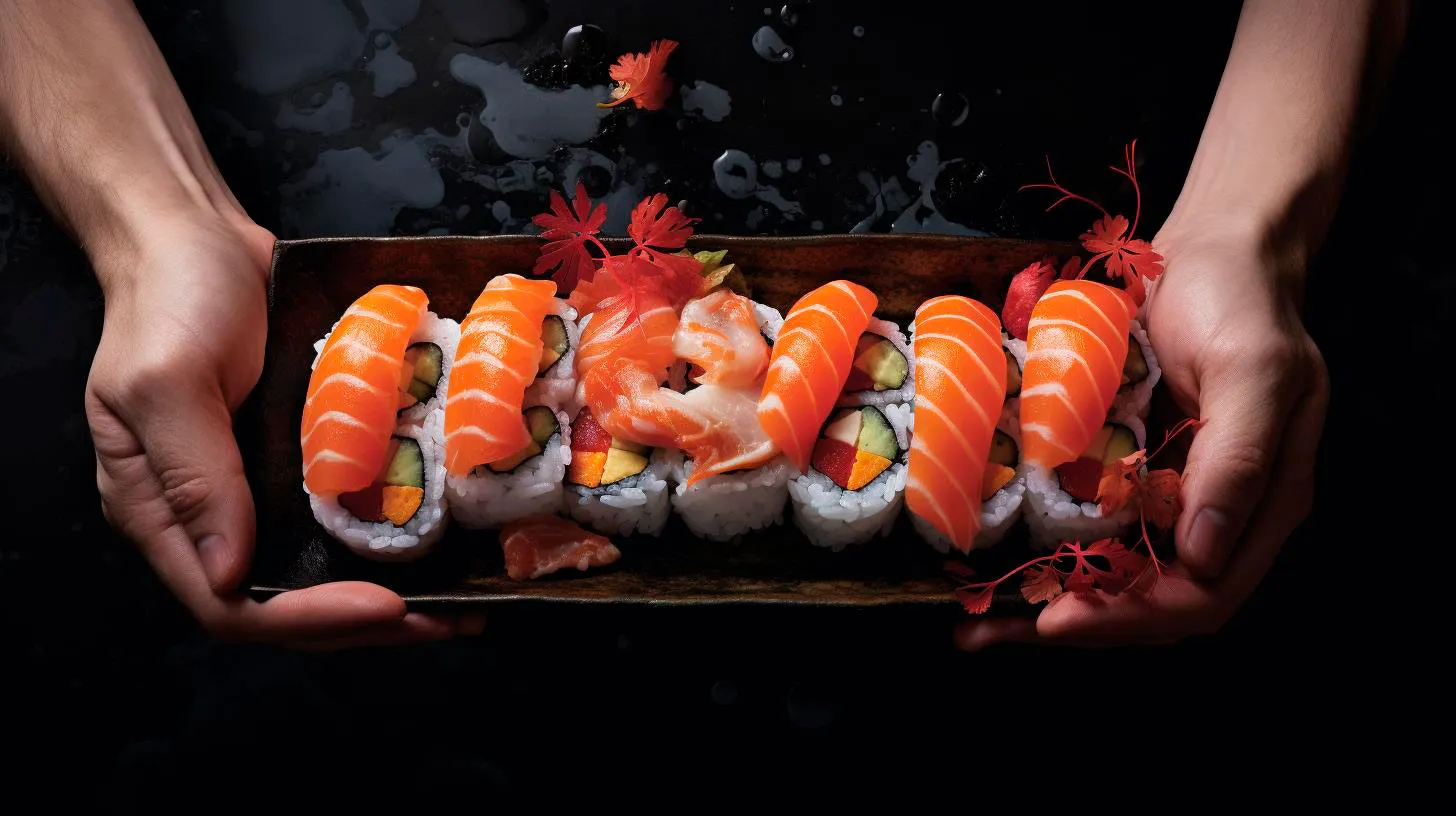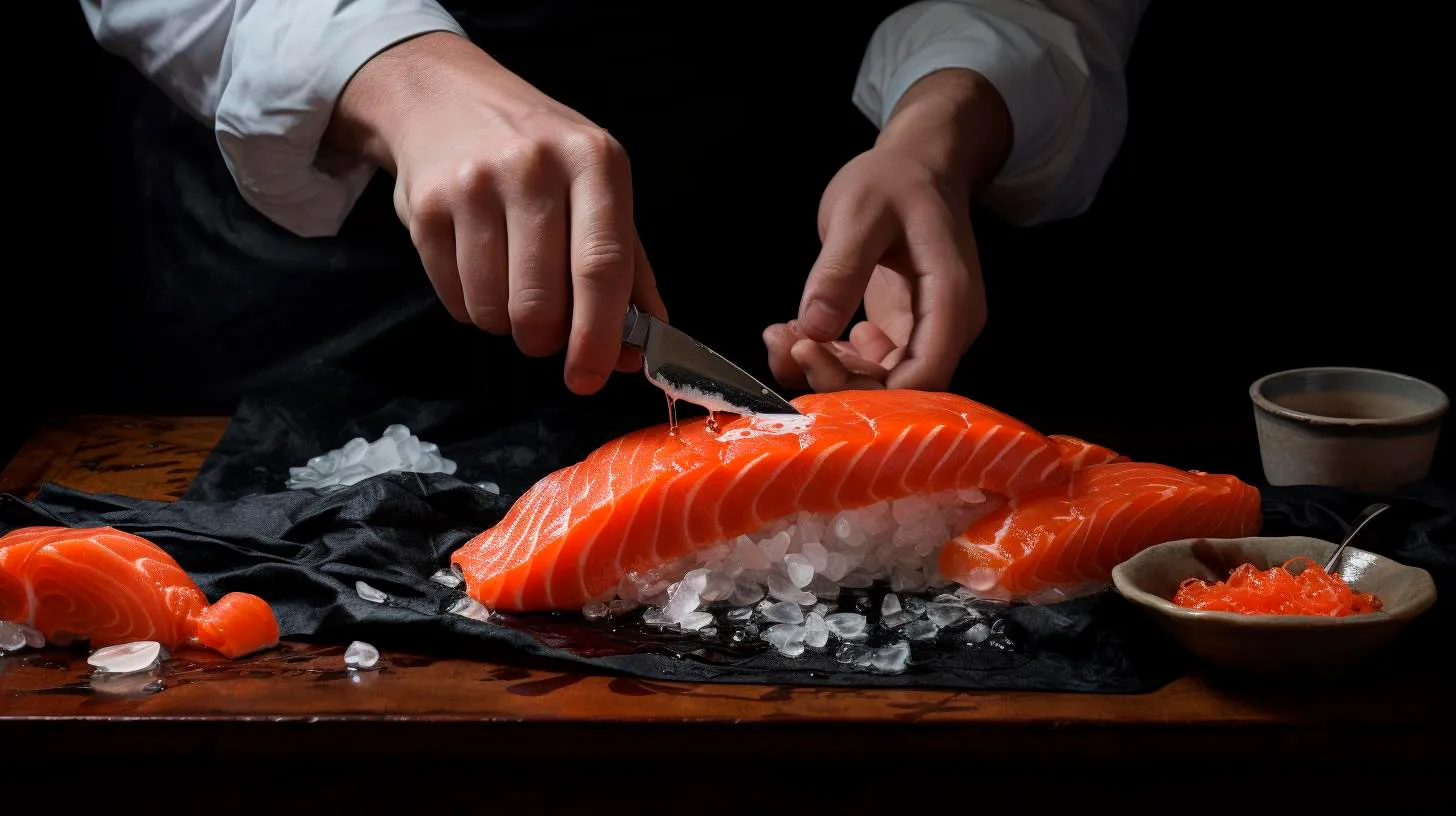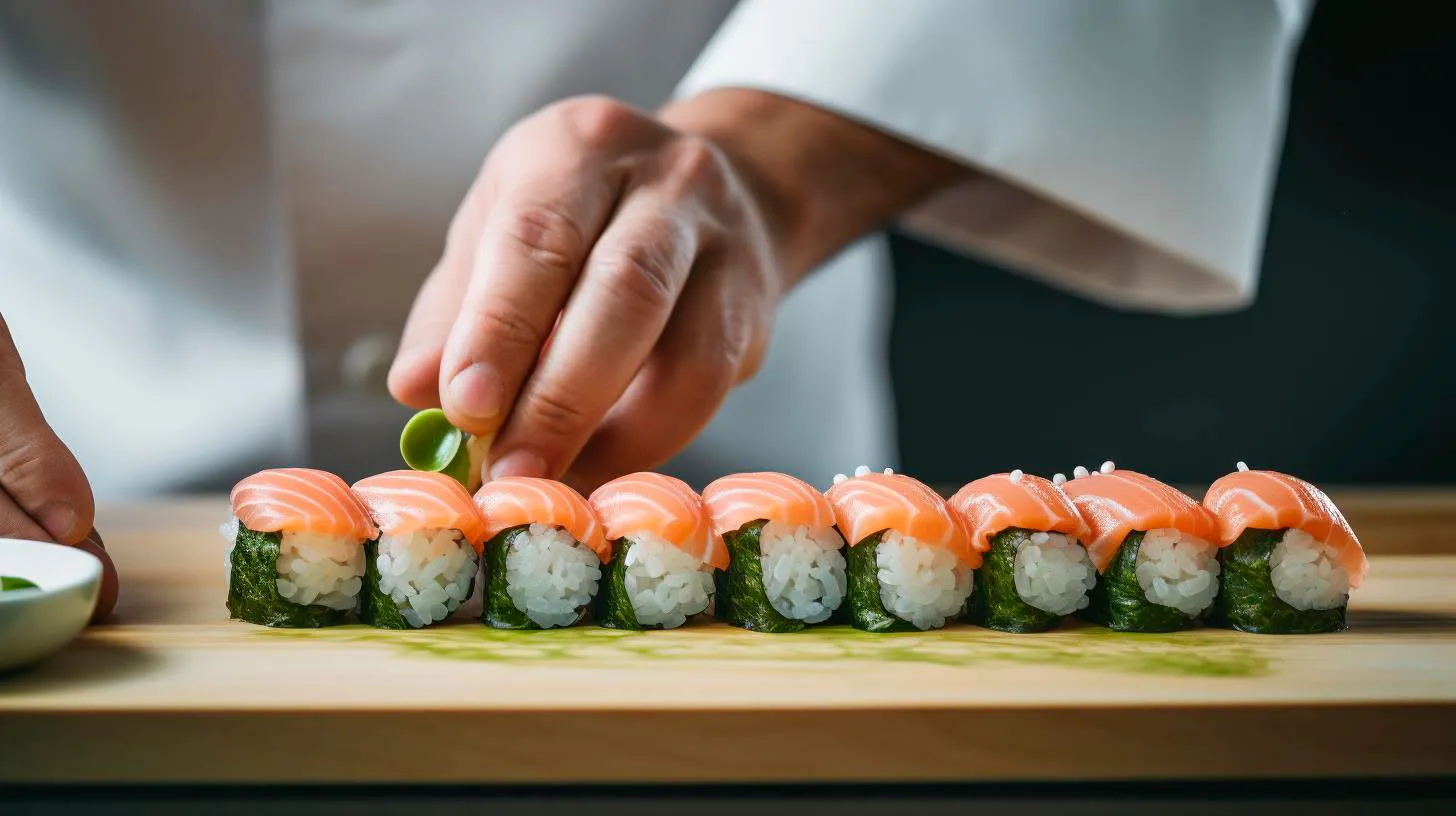Samurai Cuisine: Unraveling the Role of Sushi in Ancient Japan
In this article, we delve into the rich history of sushi and its ties to the samurai culture, exploring how this iconic dish has stood the test of time.
The Birth of Sushi: A Taste of Ancient Japan
The story of sushi begins in ancient Japan, where it was initially developed as a means of preserving fish. The Japanese relied heavily on fishing, and preserving the catch was of utmost importance in a time when refrigeration technology was non-existent. By fermenting fish with salt and rice, they discovered a preservation technique that not only prolonged its shelf life but also enhanced its flavor.
The original form of sushi, known as “narezushi,” involved placing fish in barrels with layers of salt and rice. Over time, the rice would ferment and acidify, acting as a natural preservative. The resulting product was served without removing the rice, making it different from the sushi we know today.
Key Takeaway: Narezushi was the precursor to modern sushi, showcasing how the Japanese used fermenting techniques to not only preserve fish but also create unique flavors.
The Inception of Hand-Rolled Sushi
The advent of hand-rolled sushi, or “makizushi,” came about during the Muromachi period (1336-1573). In this era, sushi began to take a more recognizable form, as the Japanese started using vinegar-infused rice as a replacement for the fermented rice. This breakthrough helped reduce the fermentation time significantly, making sushi preparation more efficient.
During this period, sushi was primarily consumed as a quick and convenient snack. The samurai, Japan’s revered warriors, played a crucial role in popularizing sushi as a staple, thanks to their preference for portable and easily consumable foods. Sushi became an ideal choice for traveling samurai, providing them with the necessary nutrition in a compact form.
Key Takeaway: The introduction of vinegar-infused rice transformed sushi, making it a more accessible and convenient option for the samurai warriors, who had a preference for on-the-go meals.
Sushi in the Edo Period: A Nationwide Phenomenon
The Edo period (1603-1868) marked a turning point in sushi’s history, as it became increasingly popular among the general population. Sushiya, or sushi stalls, began to populate the streets of Edo (now Tokyo), offering a variety of sushi options at affordable prices. This development expanded the reach of sushi beyond the samurai class, turning it into a beloved street food for the masses.
One of the standout innovations of the Edo period was the introduction of nigirizushi, the sushi style we recognize today. Nigirizushi consists of a slice of raw fish placed on a small mound of vinegared rice, often accompanied by a touch of wasabi. The simplicity of nigirizushi allowed for quicker preparation and satisfied the demand for a more flavorsome, handheld sushi option.
Key Takeaway: Sushi rapidly gained popularity during the Edo period, with sushi stalls becoming a common sight in the bustling streets of Japan’s capital. The introduction of nigirizushi catered to the growing demand for a tasty, portable meal.
Sushi’s Enduring Significance in Modern Times
The sushi we enjoy today has come a long way from its humble beginnings. Its global popularity can be attributed to the interplay of tradition and innovation, making it a versatile and adaptable dish that suits diverse palates. Here are some reasons why sushi continues to captivate food enthusiasts worldwide:
- Fusion of Flavors: Sushi offers a unique combination of delicate flavors, combining the freshness of raw fish, the tanginess of vinegar-infused rice, and the kick of wasabi. This harmonious blend appeals to both sushi purists and those seeking new taste experiences.
- Health Benefits: Sushi is often associated with a healthy lifestyle, as it is low in calories and high in essential nutrients. The richness of omega-3 fatty acids found in fish makes sushi a heart-friendly choice.
- Cultural Appreciation: Sushi has transcended borders and become a symbol of Japanese culture. Its consumption has become a way for individuals worldwide to appreciate and celebrate Japan’s culinary traditions.
Industry Statistics: According to recent surveys, the global sushi market is projected to exceed $22 billion by 2025, with North America and Asia leading the demand for this popular cuisine.
The Legacy Lives On: Sushi and the Samurai
Sushi’s journey from a preservation method to an international culinary phenomenon is a testament to its enduring qualities. Although the samurai era might be long gone, sushi remains a reminder of the rich history and cultural significance of ancient Japan.
Next time you savor a piece of sushi, reflect on its roots and the role it played in nourishing the samurai warriors. Allow the flavors to transport you back to an era where sushi was more than just a meal—it was a symbol of strength, simplicity, and the indomitable spirit of the samurai.
Key Takeaway: Sushi’s popularity continues to grow, thanks to its fusion of flavors, health benefits, and cultural significance. Understanding its historical connection to the samurai warriors allows us to appreciate its legacy even more.
So, the next time you indulge in a piece of sushi, remember the centuries-old tradition that brought it to your plate. Explore the intricate flavors, appreciate the artful presentations, and marvel at how sushi has made its mark on the world stage, while remaining deeply rooted in ancient Japan’s rich and diverse culinary heritage.
Sushi: Rich Heritage Exploring its Ties to the Feudal Samurai Era
Sushi, in its earliest form, was not the bite-sized delights we see today. It originated as a preservation method for fish during the 8th century in Southeast Asia and was introduced to Japan during the 9th century. Samurai warriors, the noble class of ancient Japan, discovered sushi’s unique ability to store fish for extended periods while on the battlefield.
The sushi we know today evolved from a form called ‘narezushi,’ which involved fermenting fish with rice. This preparation method allowed fish to be stored for months before consumption. The Samurai found this technique incredibly useful, as they could carry sushi with them while on their military campaigns.
Over time, sushi preparation methods began to transform, mainly during the Edo period (1603-1868), when Japan embraced peace and stability. It was during this era that sushi evolved into the bite-sized portions we associate with it today. A sushi master named Hanaya Yohei is credited with revolutionizing sushi by introducing ‘higawari-zushi,’ which means ‘daily changing sushi.’ His innovation involved topping bite-sized vinegared rice with fresh and seasonal ingredients, creating a harmonious blend of flavors.
The Influence of the Samurai Era on Sushi
The prestigious Samurai class had a profound impact on the development of sushi. Here are some key aspects that highlight the ties between sushi and the feudal Samurai era:
- Preservation Technique: Sushi’s fermentation method was initially developed by the Samurai for preserving fish during their campaigns. This technique allowed them to have a steady food supply even in challenging circumstances.
- Travel-friendly Meal: The portable nature of sushi made it an ideal meal for Samurai warriors on the move. Its compact size and long shelf life made sushi a convenient option during their military expeditions.
- Health Benefits: Sushi’s fermentation process not only preserved fish but also provided essential nutrients. Samurai warriors relied on this nutritious source of food to sustain their strength and stamina during battles.
- Seasonal Ingredients: Just as Samurai warriors had to adapt to their changing environment, sushi masters started incorporating seasonal ingredients to add variety and freshness to their creations. This practice continues to be a fundamental aspect of sushi preparation.
The Significance of Sushi in Japanese Culture
Sushi’s ties to the feudal Samurai era and its subsequent evolution have made it an integral part of Japanese culture. Here are a few notable aspects:
- Culinary Heritage: Sushi represents Japan’s rich culinary heritage, showcasing the country’s dedication to craftsmanship and the art of taste.
- Ritualistic Experience: Traditional sushi dining is an experience that follows precise customs and rituals. From the way sushi is served to the respectful interaction between chef and customer, sushi embodies the importance of etiquette in Japanese culture.
- Global Influence: Sushi has transcended borders and has become a global phenomenon. The fusion of flavors and innovative twists brought by sushi chefs around the world reflect the versatility and cross-cultural appeal of this ancient Japanese dish.
Key Takeaways
- Sushi originated as a preservation technique used by Samurai warriors during the feudal era.
- The bite-sized sushi we know today evolved during the Edo period when Japan experienced stability and peace.
- The Samurai’s influence on sushi can be seen in its preservation technique, portability, and use of seasonal ingredients.
- Sushi has become an iconic part of Japanese culture, representing culinary heritage and meticulous craftsmanship.
- The global popularity of sushi showcases its cross-cultural appeal and adaptability.
As you indulge in a plate of sushi, take a moment to appreciate the rich history behind this exquisite dish. The ties to the feudal Samurai era provide a deeper understanding of the cultural significance and the journey that sushi has embarked upon to become the global sensation it is today.
The Evolution of Sushi: Unveiling its Samurai Origins
In this article, we will delve into the rich history of sushi and explore its fascinating journey from ancient Japan to the global sensation it is today. Brace yourself for a captivating exploration of sushi’s samurai origins!
The Origins of Sushi
Sushi originated in Southeast Asia over 2,000 years ago. People of this region, particularly along the Mekong River, were known for preserving fish in fermented rice. This technique allowed them to keep fish edible for long periods.
Over time, this preservation method made its way to Japan. However, it wasn’t until the 8th century that sushi evolved into the form we recognize today. At this time, Japanese fishermen started to combine the fermented rice with fresh fish, creating a delightful combination of flavors.
Sushi and the Samurai
During the Muromachi period (1336-1573), sushi gained popularity among the samurai class. Samurai warriors required a portable, nutritious, and long-lasting meal for their military activities. Sushi provided the perfect solution as it fulfilled all these requirements.
Samurai warriors would carry sushi with them during battles as a quick and convenient source of sustenance. The rice acted as an energy booster, while the fish provided necessary proteins and nutrients. Sushi became an integral part of the samurai culture, symbolizing strength, resilience, and honor.
Edomae Sushi: The Edo Period Sensation
Fast forward to the Edo period (1603-1868), sushi underwent another transformation. Chefs began to experiment with new techniques and ingredients to enhance the flavors of their sushi creations.
During this period, known as the Edomae era, nigiri sushi (hand-pressed sushi) gained popularity. Chefs discovered that by combining vinegared rice with fresh fish, the flavors were heightened, creating a new sensation in sushi.
Moreover, advancements in fishing techniques and transportation allowed fish to be delivered from remote regions, further expanding the variety of fish used in sushi.
The Global Revolution
While sushi remained a local culinary treasure for many centuries, it wasn’t until the 20th century that sushi began its global conquest.
In the 1960s, sushi restaurants began to open outside of Japan, particularly in the United States. Initially, sushi faced resistance from some Americans who were not accustomed to raw fish. However, with time, sushi became a trendy and sought-after cuisine.
Today, sushi is enjoyed and embraced by people of all cultures, truly a symbol of global fusion in the culinary world. The versatility and health benefits of sushi have made it a favorite choice for many.
Sushi’s Health Benefits
- Rich in Omega-3 Fatty Acids: Fish used in sushi, such as salmon and tuna, are packed with Omega-3 fatty acids, known for their heart-healthy benefits.
- Low in Calories: Sushi is generally low in calories, making it an excellent choice for those watching their weight.
- Good Source of Protein: The fish in sushi provides high-quality protein, essential for muscle development and overall health.
- Rich in Antioxidants: Sushi often includes vegetables, such as seaweed, cucumber, and avocado, which are rich in antioxidants that promote good health.
Key Takeaways
- Sushi originated in Southeast Asia over 2,000 years ago, eventually making its way to Japan.
- The samurai class embraced sushi as a portable, nutritious, and long-lasting meal.
- The Edomae period brought new flavors and techniques to sushi, including nigiri sushi.
- Sushi gained global popularity in the 20th century, becoming a beloved cuisine worldwide.
- Sushi offers various health benefits, including Omega-3 fatty acids, low calorie content, and rich antioxidants.
Next time you savor a delicious piece of sushi, remember the samurai warriors who enjoyed it centuries ago. Sushi continues to evolve, adapting to new tastes and global influences while still preserving its rich history and cultural significance. So, indulge in this delectable dish and celebrate the evolution of sushi!
From Samurai Tables to Modern Plates: Tracing Sushi’s Historical Journey
The Origins of Sushi
Believed to have originated in Southeast Asia around the 4th century BC, sushi started as a way to preserve fish by fermenting it with rice and salt. This initial form of sushi was called “narezushi,” and it wasn’t until the 8th century AD that the Japanese began eating the rice along with the fish.
Over the centuries, sushi continued to evolve, becoming a staple of Japanese cuisine. It wasn’t until the Edo period (1603–1868) that sushi took a more recognizable form as we know it today. During this time, street food vendors began selling sushi to the general public, making it popular among commoners and the elite alike.
The Evolution of Sushi
The art of sushi making has significantly evolved over the centuries. Traditional sushi chefs, called itamae, painstakingly train for years to master the delicate art of preparing sushi. Here are a few notable advancements in sushi techniques:
- Nigiri: During the 19th century, nigiri sushi emerged, revolutionizing the sushi-making process. Nigiri sushi consists of fresh fish placed atop a small mound of vinegared rice, providing an exquisite blend of flavors.
- Sashimi: Although not technically sushi, sashimi deserves a mention. This dish offers thin slices of raw fish served without rice, highlighting the incredibly fresh flavors.
- Maki: The mid-20th century brought about the invention of maki sushi, where various ingredients are rolled inside a sheet of seaweed (nori) and rice. Maki sushi introduced a new creative outlet for sushi chefs and added versatility to the cuisine.
Sushi’s Global Popularity
With the rise of globalization, sushi quickly spread beyond the shores of Japan, capturing the hearts and taste buds of millions worldwide. Here are a few reasons why sushi has gained international popularity:
- Health Benefits: Sushi is often considered a healthy option due to its reliance on fresh fish, nutrient-rich seaweed, and minimal use of unhealthy fats.
- Cultural Appeal: Sushi offers a unique cultural experience, allowing individuals to explore the flavors and traditions of Japan.
- Variety: Sushi’s versatility means there is something for everyone, catering to a range of dietary preferences and restrictions.
Key Takeaways
Sushi has come a long way since its humble origins. Here are a few key takeaways from the historical journey of sushi:
- Sushi has a rich and fascinating history, originating from Southeast Asia and evolving over centuries in Japan.
- The Edo period played a crucial role in popularizing sushi among all social classes and establishing it as an iconic Japanese dish.
- The art of sushi-making has seen significant advancements, from nigiri and sashimi to the creation of maki sushi.
- Sushi’s global popularity can be attributed to its health benefits, cultural appeal, and diverse range of flavors.
So, the next time you savor a delicious sushi roll, take a moment to appreciate its historical journey—from samurai tables to modern plates—bringing you a culinary masterpiece that blends tradition, artistry, and global appeal.



